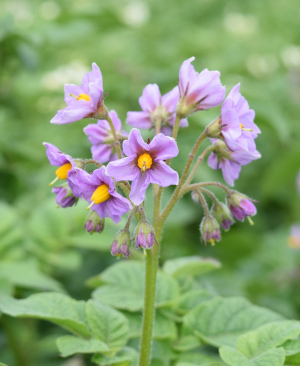
No Small Potatoes. Part II.
Previous post on potato lessons for insectivores described a long road undertaken by indigenous people of South America towards making potatoes edible. Thanks to their efforts, the spuds could already be eaten without undergoing detoxification when the Europeans arrived in South America.
Spaniards were the first Europeans who encountered potatoes after they invaded and overrun the Inca state. Although conquistadores were mostly interested in plundering gold and silver rather than studying applied botany, potatoes still made it back to the Old World together with other American curiosities. At first, potatoes were grown in botanical gardens and aristocratic estates. Cut potato flowers were used in bouquets and corsages, while tubers were served as a novelty food for the rich and the noble. Interestingly, tubers briefly developed an absolutely undeserved reputation of being aphrodisiacs. That alleged characteristic may have boosted their popularity among some consumers, but eventually the claim faded away.
Potato’s move from an exotic item to a crop that currently serves as an embodiment of European agricultural mainstream was not easy. Peasants were reluctant to grow them, complaining about bland taste and additional work required for planting tubers as opposed to planting seeds. Moreover, tubers had a lumpy and somewhat irregular shape, as opposed to round and elegant turnips and radishes. That was gross, almost like swallowing a cricket. Rumors spread that eating potatoes may cause leprosy because tuber appearance reminded people of disfigured appendages of leprosy patients at advanced stages of this disease.
Just as hunger may have been responsible for the original domestication of potato, it was instrumental in promoting this crop in Europe. For example, the Seven Year War combined with failing grain harvests was the turning point for potato adoption in Germany. Similarly, the Irish resorted to growing this crop to survive under the oppressive rule of their British overlords. Spuds yielded significantly more calories per unit of area compared to other staple crops. They were also more nutritious, including being high in vitamin C. So, it was possible to survive on a diet of mostly potatoes and pretty much nothing else. In addition, potatoes were more difficult to store and transport than grain. Therefore, there was less of a chance that they would be taken away by force as procurements for military needs, taxes, or rent payments. As a result, people started to increasingly warm up to the idea of growing this foreign crop.
Educated and ruling classes (depending on people, this may or may not be the same thing, including at present time) generally recognized the benefits of potato farming earlier than the rest of the population. Planting potatoes was encouraged through government mandates, distribution of free seed, tax breaks, and educational campaigns. An important public figure who really distinguished himself in that regard was Frederick the Great of Prussia, who is sometimes referred to as Potato King. Another potato enthusiast was Antoine-Augustine Parmentier. He was taken as a prisoner of war by the Prussians and discovered the value of potato in captivity. After returning to France, Parmentier put a lot of effort in promoting nutritional value of this vegetable. That included a famous exercise in reverse psychology, when during the day a potato field was guarded by armed soldiers, who prevented anyone from approaching it. The guards were withdrawn at night, allowing the curious locals to steal apparently very valuable tubers and to try for themselves what the fuss was all about.

Eventual adoption of potatoes as a staple crop resulted in a very substantial improvement in the quality of life, especially in the lower strata of societies. It also facilitated the Industrial Revolution by providing relatively inexpensive and nutritious food to people flocking to cities in search of work at the newly built factories and warehouses. Ultimately, formerly despised and rejected tubers began to comprise a significant part of the human diet all over the world. Will insect follow the suite? Time will tell, and probably fairly soon.
